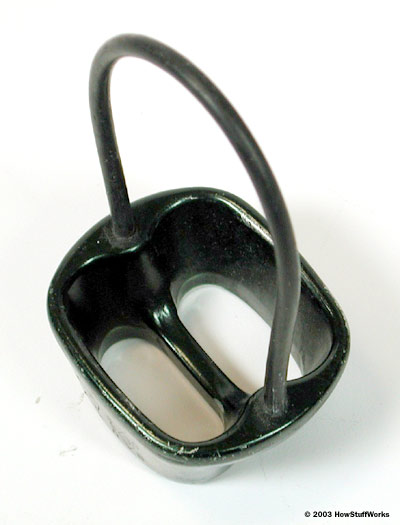How to Draw a Person Rock Climbing Easy
The first climber to climb the route is known as the lead climber. While he/she is climbing, the lead climber is protected by the rope attached to his/her harness. The other end of the rope is held by the second climber, who is known as the belayer. The belayer runs the rope through a belay device attached to his/her harness and feeds rope out as the lead climber rises.

Belay device
As the lead climber climbs, he/she will come to the first bolt on the rock wall. A bolt is a permanent anchor that has been drilled into the rock. There's a metal loop attached to the bolt. The lead climber uses a quickdraw to connect the rope to the bolt. A quickdraw is a pair of carabiners attached together by strong nylon webbing. The lead climber hooks the carabiner on one end of a quickdraw to the bolt, and runs the rope through the second carabiner on the other end of the quickdraw. The lead climber proceeds up the route, hooking into each bolt as he/she comes to it.
If the lead climber falls, the belayer will grab the rope to arrest the fall. The maximum distance that the lead climber can fall is equal to twice the distance between the last bolt and his/her current position, plus the length of slack left in the line by the belayer, plus the stretch of the rope. Climbing rope stretches to absorb the shock of the fall. So, if the lead climber is 4 feet (1.2 meters) above the last bolt that he/she clipped into, the climber will fall 8 feet (4 feet to get even with the bolt and then 4 feet past it), plus the length of the slack in the line, plus the length that the rope stretches. Perhaps 10 to 12 feet (3.4 meters), in other words.
The lead climber can climb to a maximum height equal to about half the length of the rope. If the lead climber goes any higher than that, it will not be possible for the belayer to lower him/her back to the ground if the lead climber falls and is injured. Since most ropes are 50 to 60 meters long, it means that the distance that the lead climber can climb before stopping is 25 to 30 meters (75 to 90 feet).
The lead climber will climb to a ledge, tie into an anchor in the rock with a short piece of rope or webbing, and the two climbers switch roles. The lead climber become the belayer from above for the second climber. The second climber detaches and collects the quickdraws placed by the lead climber as he/she climbs.
Once the lead climber and the second climber are together again, they have completed the first pitch. They will then repeat the process to climb the second pitch, and so on, until they reach their destination.
Traditional climbing follows the same steps. However, instead of attaching to pre-placed bolts, the lead climber carries and places temporary protection (aka pro) along the way. Protection is placed into cracks in the rock and comes in several different forms:
- Wedges
- Nuts
- Hexes
- Cams
Check out Sportextreme: active protection and Sportextreme: passive protection for details and photos.
The lead climber places protection into cracks as he/she climbs, and the second climber removes all of it as he/she follows. The placement of protection is obviously a crucial skill, since protection devices are the only thing that stand between life and death in a fall. The protection must be placed so that it locks into the rock and holds firm during the stress of a fall.
For more information on rock climbing and related topics, check out the links on the next page.
Source: https://adventure.howstuffworks.com/outdoor-activities/climbing/rock-climbing.htm
0 Response to "How to Draw a Person Rock Climbing Easy"
Post a Comment